- Home ›
- NZ Regions ›
- Waikato ›
- Buried Village
Buried Village Rotorua
Buried Village near Rotorua is just a fifteen minute, and scenic, drive from Rotorua past the Green and Blue Lakes on the Tarawera Road.
In 1931, nearly fifty years after the eruption on June 10th in 1886 of Mount Tarawera, the Te Wairoa excavation began. The eruption of Mt Tarawera and Lake Rotomahana resulted in devastation of a vast expanse of the surrounding countryside killing over 150 people in the process, although the number of deaths has never been fully determined.
To give you a bit of background to the famous Te Wairoa Buried Village, nobody expected Mount Tarawera to erupt with such violent and incredibly destructive results. This was the biggest natural disaster in the history of New Zealand.
The unique Pink and White Terraces were the eighth wonder of the world and were completely destroyed amid over four hours of eruption where the ash, rocks, and mud buried the Te Wairoa village. It is said that the noise of the eruption and explosions could be heard, and the glow in the sky could be seen, from Auckland.
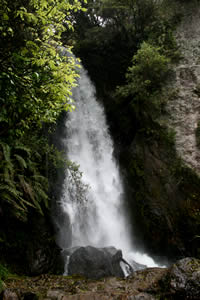
Te Wairoa Falls
Although there were three villages buried by this volcanic eruption, only the one village of Te Wairoa has been excavated to date. If you can imagine the horrific scene following the eruption, that of five thousand miles of countryside buried, you will know how the rescuers must have felt when faced with such a task.
There were around 70 houses in the village of Te Wairoa and approximately two hundred and fifty people living there. Over one hundred and fifty lost their lives. There were some warnings prior to the eruption, such as; level changes in the lake, earchquakes, and an increase in thermal activity.
Unfortunately, as demonstrated in many of the world’s similar natural disasters, the size and devastation of this eruption could not be foreseen enough to have warranted evacuation at the time.
Visiting Buried Village
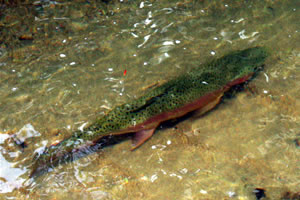
Giant Rainbow Trout in Buried Village Stream
A visit to Te Wairoa Buried Village provides you with an experience through the Museum of Te Wairoa and a variety of excavations and exhibits, a beautiful large and relaxing twelve acre park to walk around through native New Zealand bush amidst volcanic scenery.
Part of this walk gives you a chance to see wild giant Rainbow Trout inhabiting the Te Wairoa Stream and the stunning Wairere Falls.
Among the facilities at Buried Village Rotorua, there are a tea garden and café where you can relax and get served freshly cooked food, quality coffee, and Devon style teas. There is also a souvenir shop that displays books about Maori culture and New Zealand history, and authentic Maori crafts and carvings.
From my experience I think two hours is a good length of time to allow for really making the most of visiting this Buried Village in the Bay of Plenty region of NZ, looking round the museum and shop, having a drink and snack, and walking around the park.
The Museum of Te Wairoa
Luckily we just got to the museum at the start of a guided museum tour which was much more informative that self-guiding. The stories told by a local Maori were fascinating and far more emotional that the visit would have been if we had just wandered around the museum by ourselves. There were stories of the Te Wairoa village, the voyages that were made to the Pink and White Terraces, and all about the terrible night of the eruption that destroyed everything.
There are archaeological displays, and many artifacts in the museum that have been recovered from houses in the village Te Wairoa’s hotel, the Rotomahana Hotel.
Archaeology and Excavations
Because Te Wairoa has been carefully excavated you can get a full flavor of what life was like in this historic village and area. Buildings that were occupied by settlers, and Maori whare were dug down to the original floor levels during archaeological excavations that started in 1931 with the arrival of Reg and Vi Smith.
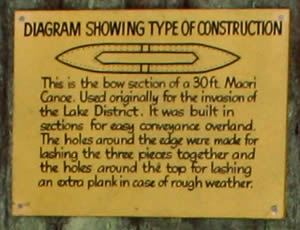
Diagram of 30ft Maori War Canoe
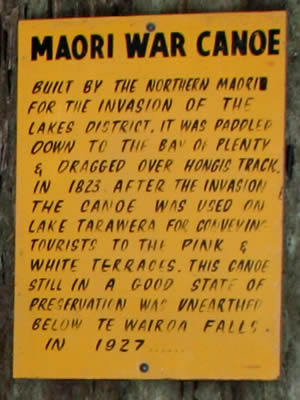
Maori War Canoe Information Board
The Smith family, over three generations and more than eighty years, have been looking after this award winning and unique heritage site for the benefit of all the visitors that come every year to learn about its historic and natural past.
There were a few small houses, a flour mill, pioneer cottage, blacksmiths, schoolhouse, and of course the famous Rotomahana Hotel. Despite the horrific history of the destruction and burial of this village and surrounding area, it is a very peaceful and relaxing atmosphere today.
Maori War Canoe / Buried Village Rotorua
Left: Diagram Showing Type of Construction.
This is the bow section of a 30ft Maori Canoe. Used originally for the invasion of the Lake District. It was built in sections for easy conveyance overland. The holes around the edge were made for lashing the three pieces together and the holes around the top for lashing an extra plank in case of rough weather.
Left and Below: Maori War Canoe.
Built by the Northern Maori for the invasion of the Lakes District. It was paddled down to the Bay of Plenty and dragged over Hongis Track. In 1823 after the invasion the canoe was used on Lake Tarawera for conveying tourists to the pink and white terraces. This canoe still in a good state of preservation was unearthed below Te Wairoa Falls in 1927.
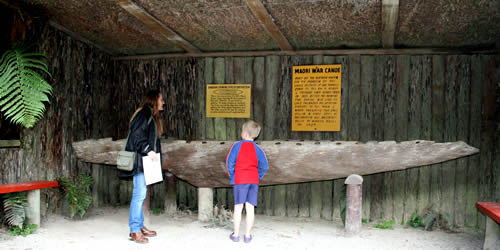
Bow section of 30ft Maori Canoe
Found below Te Wairoa Falls, Rotorua Buried Village in 1927
Tours and the Te Wairoa Tearooms

At different times of day there are complimentary guided tours of the park that take around thirty minutes or so or you can pick up a guide sheet and follow it on a self-guided tour.
Another alternative if you will be with a large group are the exclusive tours for ten or more visitors, these will have to be prior arranged.
The Te Wairoa Tearooms can cater for around a hundred visitors with inside seating, a terrace that is a covered area, and an outdoor tea garden with a child’s play area next to it.
Alternatively you could take your own food and have a picnic in the park.
Visit the Buried Village website.